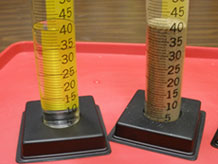What happens when we add earth materials to water?
Plan Investigation 4.3

Cheerios … jellybeans … sand … gravel. What do these things have in common? They are all granular materials, assemblages of individual pieces or grains with "empty" spaces between them. Unlike solids and liquids, granular materials have three volumes: the volume of the solid material, the volume of the space between the grains, and the combined bulk volume.
In this investigation, students continue their investigation of volume and water displacement by adding solid, liquid, and granular materials to water and recording the volumes that result. By the end of the lesson, students will understand that the volumes of solids and liquids can be added directly. However, when a granular material is added to a liquid, the combined volume is equal to the sum of the separate volumes minus the volume of the air between the grains in the sample.
Learning Goals
- Become familiar with a graduated cylinder
- Understand that the volumes of solids and liquids can be added together
- Understand that granular materials displace water differently than solids and liquids
| Sequence of experiences | ||
|---|---|---|
| 1. Ask the question | All Class | 10 Mins |
| 2. Explore volumes in water | Small Groups | 20 Mins |
| 3. Make meaning | Discussion | 15 Mins |
Materials and Preparation
For the class:
- Post the investigation question in a place where all students can see it.
- 1 strainer (for clean-up)
- 1 50cc graduated cylinder filled with 40cc of water
- 1 100cc graduated cylinder filled with 40cc of sand
- 10 centimeter cubes
For each tray:
- 1 cup holding at least 40 centimeter cubes
- 1 20oz cup for use as a "waste bucket"
- 2 plastic forks
- 2 pipettes
- 2 3oz cups approximately two-thirds full of bulk gravel
- 2 20oz cups approximately half full of water
- 2 50cc graduated cylinders
- 2 140cc graduated cylinders - student-made measuring cups, from Investigation 3.2
- 2 rocks or minerals that will fit in the cylinders; sandstone or granite works well
- 4 paper towels
Concept Cartoon

The Volume Concept Cartoon is typically used as a formative assessment at the end of this investigation.







